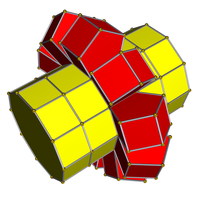Pentagonal-decagonal duoprism
Jump to navigation
Jump to search
| Pentagonal-decagonal duoprism | |
|---|---|
 | |
| Rank | 4 |
| Type | Uniform |
| Notation | |
| Bowers style acronym | Padedip |
| Coxeter diagram | x5o x10o ( |
| Elements | |
| Cells | 10 pentagonal prisms, 5 decagonal prisms |
| Faces | 50 squares, 10 pentagons, 5 decagons |
| Edges | 50+50 |
| Vertices | 50 |
| Vertex figure | Digonal disphenoid, edge lengths (1+√5)/2 (base 1), √(5+√5)/2 (base 2), and √2 (sides) |
| Measures (edge length 1) | |
| Circumradius | |
| Hypervolume | |
| Dichoral angles | Pip–5–pip: 144° |
| Dip–5–dip: 108° | |
| Dip–4–pip: 90° | |
| Central density | 1 |
| Number of external pieces | 15 |
| Level of complexity | 6 |
| Related polytopes | |
| Army | Padedip |
| Regiment | Padedip |
| Dual | Pentagonal-decagonal duotegum |
| Conjugate | Pentagrammic-decagrammic duoprism |
| Abstract & topological properties | |
| Flag count | 1200 |
| Euler characteristic | 0 |
| Orientable | Yes |
| Properties | |
| Symmetry | H2×I2(10), order 200 |
| Flag orbits | 6 |
| Convex | Yes |
| Nature | Tame |
The pentagonal-decagonal duoprism or padedip, also known as the 5-10 duoprism, is a uniform duoprism that consists of 5 decagonal prisms and 10 pentagonal prisms, with two of each joining at each vertex.
The convex hull of two orthogonal pentagonal-decagonal duoprisms is either the pentagonal duoexpandoprism or the pentagonal duotruncatoprism.
Gallery[edit | edit source]
Vertex coordinates[edit | edit source]
The vertex coordinates of a pentagonal-decagonal duoprism, centered at the origin and with unit edge length, are given by:
- ,
- ,
- ,
- ,
- ,
- ,
- ,
- ,
- .
Representations[edit | edit source]
A pentagonal-decagonal duoprism has the following Coxeter diagrams:
- x5o x10o (






 ) (full symmetry)
) (full symmetry) - x5x x5o (






 ) (H2×H2, decagons as dipentagons)
) (H2×H2, decagons as dipentagons) - ofx xxx10ooo&#xt I2(10)×A1 axial)
- ofx xxx5xxx&#xt (H2×A1 symmetry, dipentagonal axial)
External links[edit | edit source]
- Bowers, Jonathan. "Category A: Duoprisms".
- Klitzing, Richard. "padedip".
- Quickfur. "The 5,10-Duoprism".











